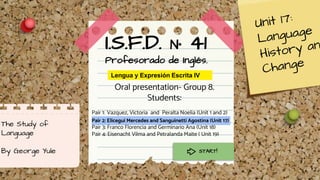
Lee 4 - Group 8 - Unit 17
- 1. I.S.F.D. N° 41 Profesorado de Inglés. START! Lengua y Expresión Escrita IV Oral presentation- Group 8. Students: Pair 1: Vazquez, Victoria and Peralta Noelia (Unit 1 and 2) Pair 2: Elicegui Mercedes and Sanguinetti Agostina (Unit 17) Pair 3: Franco Florencia and Germinario Ana (Unit 18) Pair 4: Eisenacht Vilma and Petralanda Maite ( Unit 19) The Study of Language By George Yule
- 2. We can define philology as the investigation of the features of older languages, and the way in which they develop into modern languages; it involves the study of language history and change. 19th century the discovery that a variety of languages were members of the same family “family trees” show how languages were related with each other in a hierarchical structure. Language history and change
- 3. FAMILY TREES Suggested by Sir William Jones Realised that languages from different areas have some common ancestor. NEXT! It was not possible to describe the ancestor from any existing record. It had to be hypothesized on the basis of similar features. Proto original form of a language. Indo European The source of modern languages Proto-Indo-European “Great Grandmother”
- 4. Family Trees Family connections Records of an older generation give a clearer picture of languages relations. Cognates When a word in one language has a similar form and is/was used with a similar meaning in another language. For example: English words mother, father and friend; are cognates of German words mutter, vater and freund. Close similarities Same words extremely unlikely evidence for proposing a family connection
- 5. Comparative reconstruction The goal of comparative reconstruction is to recreate what would have been the original or “proto” form in the common ancestral language by using the information cognates give us. During this process there are some principles to take into consideration: Family trees The majority principle: If in a cognate set there is a predominant sound with only one or little few exceptions, we can say that the majority have retained the original sound. The natural development principle: 1. Final vowels often disappear (vino → vin) 2. Voiceless sounds become voiced, typically between vowels (muta → muda) 3. Stops become fricatives (ripa → riva) 4. Consonants become voiceless at the end of words (rizu → ris)
- 6. Sound reconstruction Examples of three languages ¿What was the most likely form of the initial sound in the original source of all three? A and B = same initial sound C = different initial sound The initial sound of A and B is older than the one in C Family Trees Comparative reconstruction
- 7. Word reconstruction Examples of three languages ¿What was the most likely original form source of all three? 2 and 3 = /p/ majority principle 1 = /b/ voiceless sounds become voiced, typically between vowels . 1 and 3 = final vowels tend to disappear. Family Trees Comparative reconstruction 2 is the most likely original form
- 8. The history of English Written records from an older period may not bear any resemblance to the written form of today’s language. History of English: Middle English: 1100 to 1500 Early Modern English: 1500 to 1700 Modern English: after 1700 Old English: before 1100
- 12. Sound changes The history of English Influences from the outside are external changes. Changes within the historical development of English are internal changes. In a few changes from Middle to Modern English, some sounds disappeared sound loss.
- 13. Sound changes “Silent letters" Some words lost sounds, but kept the spelling, resulting in the “silent letters”. For example: Initial velar stops are no longer pronounced before nasals, but we still write the word knee with the remnants of earlier pronunciations. Metathesis It is a reversal in position of two sounds in a word, illustrated in the changed versions of these words from their earlier forms. acsian → ask frist → first The reversal of position in metathesis can sometimes occur between non- adjoining sounds. The history of English
- 14. Sound changes The history of English Another type of sound change, known as epenthesis, involves the addition of a sound to the middle of a word. æmtig → empty spinel → spindle timr → timber Prothesis This is, when a word in one language has a similar form and is/was used with a similar meaning in another language. For example: English words mother, father and friend; are cognates of German words mutter, vater and freund.
- 15. Word order . Old English structures ● Subject-Verb-Object ● Verb-Subject ● Subject-Object-Verb ● Object-Subject-Verb Syntactic changes The history of English Used in Modern English Double negative constructions were possible. Lost of inflexional a large number of suffixes
- 16. Semantic changes The history of English Modern English ≠ Old English Main difference *Some have words and expressions ceased to be used . Borrowed words Broadening Narrowing The change on the use or meaning of a word, to adopt a more general concept. The change on the use or meaning of a word, to adopt a more specific concept.
- 17. Diachronic and synchronic variation The history of English Change and variation are inevitable The variation in language viewed from the historical perspective of change through time. The variation in language viewed in terms of differences within one language in different places and among different groups at the same time.
- 18. CREDITS: This presentation template was created by Slidesgo, including icons by Flaticon, and infographics & images by Freepik. Bibliography Thanks for watching Yule, G. (2010). The Study of Language. New York, USA. Cambridge University Press